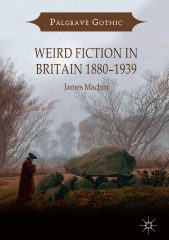Author James Machin, visiting lecturer at the Royal College of Art, London, introduces the first study on how weird fiction was developed in England by blending Victorian supernatural literature and Gothic horror tales. Instead of a complete survey of the genre, he concentrates on some key writers and certain rather unknown authors who, contrary to popular belief, deserve full credit for spreading the variety.

“The present study is a commensurate with [fellow students of weird fiction S. T.] Joshi’s and [China] Miéville’s argument that the Weird Tales iteration of weird fiction in the 1920s and 1930s was only the conclusion of a ‘high phase’ of such writing which began in the 1890s.”
Considering the huge success of all kinds of horror tales still today, be it highly popular TV shows featuring zombies, vampires or demons, or movies, fiction and video games, it is worth noting that not American authors such as H. P. Lovecraft, but mostly British authors are responsible for developing this blend of literary composition, if we follow Machin’s arguments.
In basically two large chapters on M. P. Shiel, R. Murray Gilchrist, Count Stenbock, Arthur Machen and John Buchan he meticulously lists and analyzes the literary output of those (British) authors and tries to establish a development that led to the vast popularity of the supernatural and horror genre in fin de siècle literature to pulp fiction still published. For this approach he employs a number of theories and strategies, like Pierre Bourdieu’s idea of distinction in fields of cultural production. The success of such tales was also furthered by other developments, since in the late 19th century the short story became widely spread and then it was influenced by what Machin labels “the literary Decadence of the fin de siècle.”
What makes the perception of the weird fiction development slightly problematic is the missing definition of the genre itself; “weird” tales in the 19th century could actually be any written story that included magic, the supernatural, ghosts, horror, sublime fantasies, and so forth. The word “Weird,” and its use in 19th century literary criticism, would be in today’s terms be rather described “Gothic.” Not even the most popular early author of horror tales H. P. Lovecraft could be clear in his oft-quoted nonfiction text “Supernatural Horror in Literature” (1927). He suggested that “… much of the choicest weird work is unconscious; appearing in memorable fragments scattered through material whose massed effect may be of a very different cast. … Therefore we must judge a weird tale not by the author’s intent, or by the mere mechanics of the plot; but by the emotional level which it attains at its least mundane point.”
Machin lists additional difficulties, as “… the Weird is a mode closely identified with the Gothic genre.” This problematic definition, however, takes up much of the first third of the book, linking the terminology to the works of Edgar Allen Poe, R. L. Stevenson, among other better known writers. There seems to be an understanding in literary research of the period that the classic period of Weird (literature) – that by some scholars is also called “Old Weird” or “haute Weird” – can somehow be connected with a number of writers and a magazine. “The Old Weird can be dated between 1880 and 1940, and the term is explicitly articulated with the founding of the pulp magazine Weird Tales in March 1923.”
This may not be an easy text to read, not just because some of the authors of weird fiction in focus are rather unknown, or can be depicted as “lost, prematurely dead, and failed writers,” which makes it so much more difficult to recognize their literary value. But also because except for the precondition (introduced in the Edwardian period) that a weird tale should not include the obviously horrible characters such as werewolves, witches, vampires or zombies, but be of a more refined, original, elegant and subtle nature. And that this kind of fiction is usually not a long novel but exists in the confinements of the short story. However, the introduction is excellent and many readers will perhaps be surprised by the notable weird fiction of the “lost” writers.
The final text of the title contrasts those British texts with the fiction published by the magazine Weird Tales; in the light of the previous research, the magazine suddenly has lost a bit of its originality and uniqueness, as many facets, themes and story lines published in the 1920s and 1930s have – in one way or another – already been produced by British writers roughly thirty years earlier. With that fresh interpretation, Machin concludes that “….Weird Tales was part of an existing tradition and can be credibly seen as a continuation of fin-de-siècle literary Decadence in the age of Modernism.”
Weird Fiction in Britain is certainly worth reading for any fan or student of the weird/gothic tale of the 19th century, as the mass of detail that went into this study is overwhelming, and the title is “the first cultural history of weird fiction from a British perspective.” Furthermore, it offers a lot of detail on the publishing politics and consumer buying habits of the day.
Review by Dr. A. Ebert © 2019
James Machin. Weird Fiction in Britain 1880–1939 (Palgrave Gothic Series) Palgrave Macmillan, 2018, 259 p.
